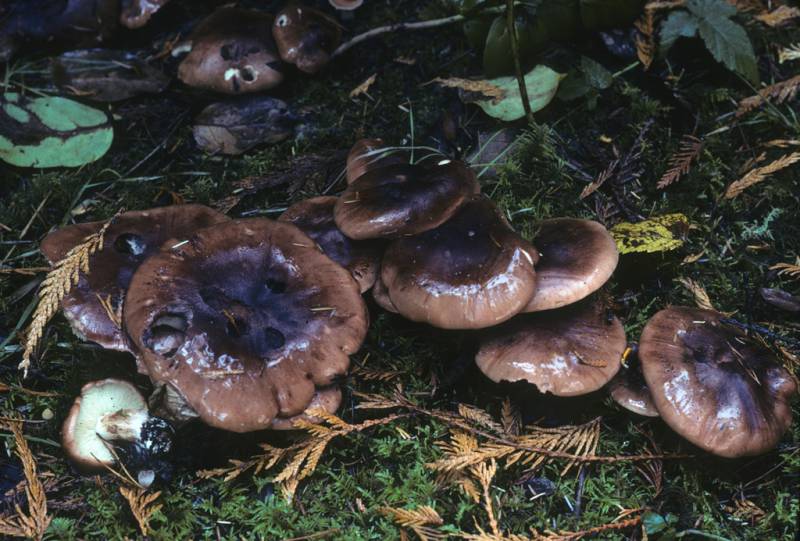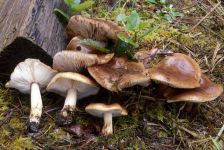Habitat: One of the characteristic fungi of the coastal Oregon shore pine woodlands. When found in this habitat, it is fairly easy to identify, but away from coastal pines, identifications in this group become extremely difficult.
Conservation Status: Not of concern
Edibility: None of these species is edible, and some or all are probably somewhat toxic.
Cap: 4-11 cm wide, convex to broadly convex, sometimes with a low, broad umbo when young, becoming plane and sometimes with a depressed center at maturity; surface viscid, becoming dry, often shiny, innately radially fibrillose and streaked; dull reddish brown on the disc, pinkish brown towards the margin; margin inrolled at first, becoming down-turned, and finally lobed and wavy, often with a short radial ridges. Flesh: white; odor farinaceous or not distinctive; taste farinaceous or bitter-farinaceous. Gills: sinuate, moderately broad, close, thin; buff when young, rapidly becoming orange-white, discoloring brown, often with red-brown edges. Stalk: 3-8 cm long, 1-2.5 cm thick, nearly equal or tapered slightly toward the base, which may be somewhat root-like, solid or hollow; surface dry, silky-fibrillose with irregular belts of recurved fibrils; pruinose and concolorous with the gills at the apex; becoming brown to brownish orange, darkening from the base upwards or when bruised or handled.
None of these species is edible, and some or all are probably somewhat toxic.
It is very similar to the European T. pessundatum (Fries: Fries) Quélet, differing only in minor microscopic details, and is one of the characteristic fungi of the coastal Oregon shore pine woodlands. When found in this habitat, it is fairly easy to identify, but away from coastal pines, identifications in this group become extremely difficult. Other look-alike species include T. fracticum (Britzelmayr) Kreisel (= T. batschii Gulden: Mort. Christensen & Noordeloos) with conifers and a sharp color change in the ring zone like that in T. aurantium, T. manzanitae T. J. Baroni & Ovrebo that occurs with manzanita, T. nictitans (Fries) Gillet (= T. flavobrunneum (Fries: Fries) P. Kummer and possibly T. fulvum (Candolle: Fries) Saccardo) with conifers or in mixed woods and with some yellow tones in the stipe and gills, T. populinum Lange with cottonwoods and aspen, T. ustale (Fries: Fries) Quélet with oaks, and T. stans (Fries) Saccardo with pines. This whole group is sorely in need of critical study world-wide, as it seems there must be more names than there are taxa! Until that happens it will be difficult to assess the presence of the different species in the PNW.
Sources: Bessette, Alan E., Arleen R. Bessette, William C. Roody, and Steven A. Trudell. Trichoolomas of North America. Austin, University of Texan Press, 2013. Trudell, Steve and Joe Ammirati. Mushrooms of the Pacific Northwest. Portland, Timber Press, Inc. 2009.
PNW Herbaria: Specimen records of Tricholoma muricatum in the Consortium of Pacific Northwest Herbaria database.
CalPhotos: Tricholoma muricatum photos.





